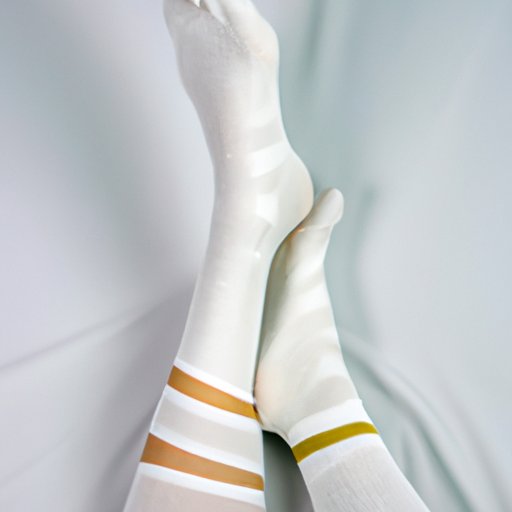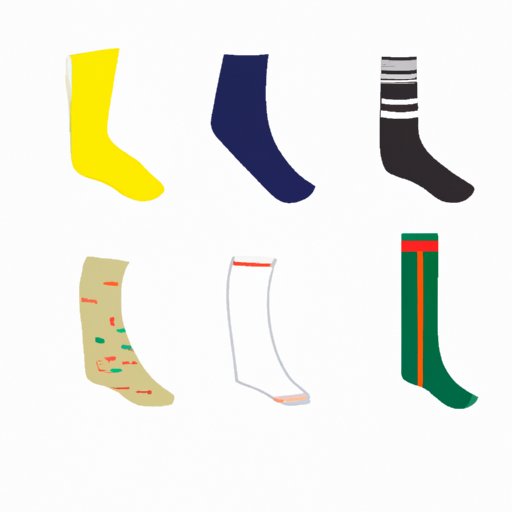
Introduction
Compression socks are designed to promote blood flow and prevent circulation-related issues. They are commonly used by athletes, travelers, and individuals with venous disorders. Healthy blood circulation is essential for optimal health, and the benefits of compression socks are well-known. However, when it comes to sleeping with compression socks on, there are few things to consider.
Importance of Healthy Circulation During Sleep
Sleep is the time when our body heals, regenerates, and rejuvenates. It is also a period when blood flow to our organs and limbs is essential for maintaining optimal health. Poor circulation during sleep can result in waking up with swollen feet or legs, numbness, or tingling sensations. It can also increase the risk of conditions like deep vein thrombosis (DVT), restless leg syndrome (RLS), and varicose veins.
Benefits of Sleeping with Compression Socks On
How Compression Socks Work
Compression socks are designed to apply pressure to the lower legs and feet, which stimulates blood flow and reduces swelling. They work by compressing the veins, arteries, and muscles in the legs, forcing the blood to flow back to the heart. The level of compression varies, with lower levels of compression designed for mild swelling and higher levels of compression for severe conditions.
Positive Impact on Blood Flow
Studies have shown that wearing compression socks while sleeping can improve blood flow and reduce the risk of venous disorders. It can also help prevent the limbs from becoming numb or tingling. Improved circulation also means better oxygenation of tissues, which can promote faster healing and reduce muscle fatigue.
Reduced Risk of Venous Disorders
Using compression socks while sleeping can also reduce the risk of developing venous disorders like DVT and varicose veins. DVT is a severe condition where blood clots form in deep veins, which can lead to pulmonary embolism or stroke. While compression socks may not completely prevent these conditions from occurring, they can certainly minimize the risk and reduce the severity of symptoms.
Disadvantages and Side Effects of Wearing Compression Socks while Sleeping
Inconvenience and Discomfort
One of the biggest drawbacks of wearing compression socks while sleeping is discomfort and inconvenience. Lack of proper fit, excessive pressure, or poor materials can cause discomfort, irritation, and pain. Compression socks can also be challenging to put on, especially for individuals with mobility or flexibility issues.
Potential for Skin Irritation
Wearing compression socks for prolonged periods can lead to skin irritation, rashes, and blisters. Poorly-designed products, inadequate hygiene, or allergies can cause skin irritation. To prevent skin irritation, it is essential to choose high-quality compression socks that fit correctly and maintain proper hygiene.
Risk of Decreased Blood Flow
While compression socks are primarily designed to improve blood flow, long-term use of high-level compression socks can lead to decreased blood flow. This can be particularly dangerous for individuals with medical conditions like diabetes or peripheral artery disease.
Safety Guidelines for Wearing Compression Socks While Sleeping
Recommended Guidelines for Wearing Compression Socks
If you are considering wearing compression socks while sleeping, it is essential to follow recommended guidelines. Generally, it is safe to wear compression socks for eight hours a day. However, if you experience discomfort or pain, it is best to remove them. Always choose the right compression level and proper fit for your needs.
Advantages and Disadvantages of Sleeping with Compression Socks
When it comes to sleeping with compression socks, there are both advantages and disadvantages. Benefits include improved blood flow, reduced swelling, and fewer instances of varicose veins. Downsides include discomfort, inconvenience, and skin irritation. It is essential to weigh the pros and cons and decide if sleeping with compression socks is right for you.
Precautions to Take While Sleeping
When wearing compression socks while sleeping, it is necessary to take precautions. Avoid sleeping in a position that puts excessive pressure on the legs or feet. Drinking enough water can also help reduce swelling. Keep your compression socks clean and dry, and if you experience discomfort, take them off immediately.

Types of Compression Socks for Sleeping
Different Levels of Compression
Compression socks come in different levels of compression, ranging from mild to severe. Mild compression is suitable for individuals who experience occasional swelling, while severe compression is designed for orthopedic conditions or individuals diagnosed with lymphedema. Always seek the advice of your healthcare provider before choosing the level of compression.
Materials Used for Compression Socks
Compression socks are made of different materials, including nylon, polyester, and spandex. Choose a material that is breathable, moisture-wicking, and gentle on the skin. Avoid materials that can cause allergies or irritation.
Comparison of Different Types in Terms of Effectiveness
There is no one-size-fits-all solution when it comes to compression socks. Always choose a product that is suitable for your specific needs and medical condition. Consult with your healthcare provider to determine which product is best for you.
Real-Life Experiences
Interviews with Individuals Who Wear Compression Socks While Sleeping
Many people wear compression socks while sleeping, and their experiences vary. Some report improved sleep quality, reduced swelling, and pain relief, while others find compression socks inconvenient and uncomfortable.
Personal Stories of Benefits and Challenges
Personal stories of people who wear compression socks while sleeping can offer valuable insights into the benefits and challenges. Stories range from individuals who use compression socks to reduce swelling during pregnancy to athletes who use compression socks to speed up recovery.
Tips for Overcoming Common Obstacles
Some common obstacles to wearing compression socks while sleeping include discomfort, poor fit, and skin irritation. Proper hygiene, adequate hydration, and choosing the right product can help overcome these obstacles. Also, following recommended guidelines, like taking them off immediately when you feel discomfort, can help.
How to Properly Wear Compression Socks While Sleeping
Recommended Steps for Putting on Compression Socks
Pulling on compression socks can be challenging, especially if you have mobility or flexibility issues. Here are the steps to follow for putting on compression socks. First, roll the sock down to the heel. Then, slip your foot into the sock and slowly unroll the sock over your ankle and up your calf. Adjust the sock for proper fit and comfort.
Tips for Effective Wearing
When wearing compression socks while sleeping, it is essential to maintain proper hygiene and keep them clean and dry. Avoid scrunching, bunching, folding, or rolling down the sock, as this can interfere with blood flow. It is also recommended to choose the right size and fit for your legs.
Reducing the Risk of Discomfort and Irritation
To reduce the risk of discomfort and irritation, it is crucial to choose high-quality compression socks that are designed for your specific condition. Always follow recommended guidelines for wearing compression socks and keep them clean and dry. If you experience discomfort or irritation, take off the socks immediately.
Alternative Methods for Improving Circulation During Sleep
Exercises and Stretches to Promote Circulation
There are various exercises and stretches that you can do to promote circulation during sleep. Leg exercises like ankle pumps, heel raises, and calf stretches can help improve blood flow. Other activities like cycling, walking, or swimming can also help promote circulation.
Changes in Sleeping Position
Changing your sleeping position can also help promote circulation. Elevating your legs with a pillow or sleeping on your back can help prevent swelling and promote blood flow. It is essential to find a position that is comfortable and supportive.
Other Products or Techniques to Support Better Sleep
There are various products and techniques that can support better sleep, including sleeping in a cool room, relaxation exercises, and meditation. Products like leg wedges or adjustable beds can also help promote circulation and reduce swelling.
Conclusion
Recap of Benefits and Drawbacks
Sleeping with compression socks on can have both benefits and drawbacks. Benefits include improved blood flow, reduced swelling, and fewer instances of varicose veins. Downsides include discomfort, inconvenience, and skin irritation.
Experts’ Final Advice on Sleeping with Compression Socks
Compression socks are generally safe for sleeping but always consult with your healthcare provider before using them. Choose products that are designed for your specific condition, maintain proper hygiene, and follow recommended guidelines.
Encouragement to Try it out for Oneself
Compression socks can offer many benefits for individuals with circulation-related issues. If you are considering wearing compression socks while sleeping, try different products, and see what works best for you. With proper guidelines and precautions, you can sleep soundly and wake up feeling your best.




